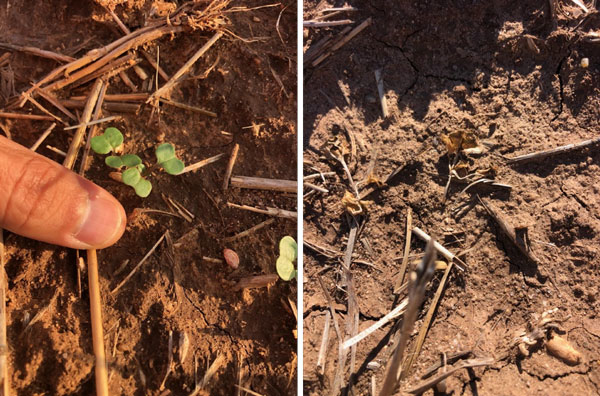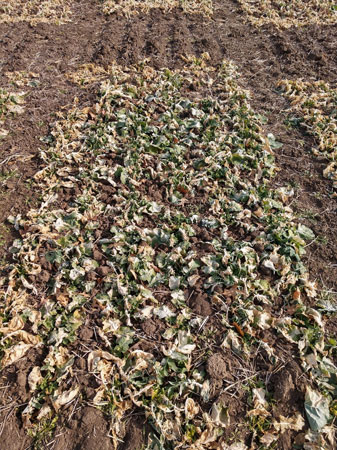Winter canola planting conditions in fall 2022 were more challenging than in recent years. Continual drought is impacting all corners of the state and in particular south-central Kansas where most canola is planted. Soil moisture in the seed zone was not present during the optimum planting window and there was no short-term forecast for precipitation. Thus, most producers chose not to plant winter canola because the risk of losing the crop was quite high. Some limited rains fell in mid-October, but then those that tried canola faced a late-emerged crop. How could dry soils and late emergence affect the winter survival of canola?
Effect of canola plant size on winter survival
Rapid and timely emergence is critical for attaining the right amount of growth before winter. Canola overwinters -- and is the most tolerant to cold temperatures -- in the rosette growth stage. At this stage, the crown (rosette) develops at the soil surface with larger, older leaves at the base and smaller, newer leaves at the center. The stem thickens but its length remains unchanged. To have the best chance at survival, a winter canola plant needs 5 to 8 true leaves, 6 to 18 inches of fall growth, a root collar diameter of ¼ to ½ inch, and an extensive root system.
On the other hand, canola that has too much top growth (typically 24 inches or more) in the fall can succumb to winterkill for a few reasons, including overuse of available soil water and nutrients, stem elongation well above the soil surface, and physical damage to the unprotected crown as winter temperatures arrive.
Planting in 2022
As mentioned above, soil moisture conditions made canola establishment challenging, if not impossible, in fall 2022. Mid-October rains fell in some areas allowing what was planted to eventually emerge, albeit a month behind optimum (Figure 1). The small amount of rain permitted minimal wetting of the upper soil profile, but canola roots would have eventually grown into dry soil. The lack of moisture kept plant growth at a minimum and below optimum. Unfortunately, colder-than-normal temperatures in mid-November took out much of the established canola because it was too small to overcome the effects of low temperatures. It was difficult to avoid the risks of delayed emergence in 2022 with soils too dry to plant under rainfed conditions. This illustrates the critical importance soil moisture plays for rapid establishment of winter canola after planting.

Figure 1. Winter canola plots were seeded into very dry soils near Norwich, KS on September 29, 2022. The photo on the left was taken November 9 following a rainfall event. The photo on the right was taken November 21 following colder-than-normal temperatures. Because of delayed emergence, the crop was not able to attain adequate growth before freezing temperatures arrived. (Photos by Cody Swinehart, producer).
In northern Kansas, mid-September rains set the stage for favorable stand establishment. Where canola was seeded on time near Manhattan and Belleville, occasional showers have allowed for adequate fall growth. However, the crop has taken on a wintery appearance as cold temperatures in November have bleached many leaves (Figure 2). Low temperatures near Manhattan dropped below freezing for 12 consecutive nights starting November 10, reaching a low of 14?F. Although the crop had started the winter acclimation process, it was not completely hardened before the cold stretch. Even so, the majority of the crowns (rosettes) of the plants remain firm and green, indicating good tolerance to the cold thus far. It will be interesting to see if additional cold weather this winter leads to winter stand loss.

Figure 2. Canola plots near Manhattan, KS on December 6, 2022. These plants are showing symptoms from cold temperatures during mid-November. Photo by Mike Stamm, K-State Research and Extension.
For producers concerned about cold temperature effects this time of year, visit canola fields about five days after the hardest freeze event. Look for bleached (whitened) leaves, wilted plants, and dead plants (dry and brown). Plant loss will be the biggest concern on canola with 2 or fewer true leaves prior to the freeze event. Canola that emerged late because of too little soil moisture will be at the greatest risk for cold temperature losses.
In next week’s e-Update, we will explore other factors that affect winter survival and discuss some current research on the topic.
For addition information on canola production, please refer to the recently revised “Great Plain Canola Production Handbook” available through K-State Research and Extension. https://www.bookstore.ksre.ksu.edu/pubs/MF2734.pdf
For more information about canola growth and development stages, please consult the K-State Canola Growth and Development poster: https://www.bookstore.ksre.ksu.edu/pubs/MF3236.pdf
Mike Stamm, Canola Breeder
mjstamm@ksu.edu
Ignacio Ciampitti, Farming Systems
ciampitti@ksu.edu